Guitar Tab Music Sheets, often simply called “guitar tabs,” are a revolutionary way for aspiring guitarists to dive into playing their favorite songs quickly and easily. Think of guitar tabs as a simplified musical roadmap specifically for guitar. While sharing some concepts with traditional music notation by indicating notes, rhythm, and techniques, guitar tabs offer a significant advantage, especially for beginners: they visually show you where to play the notes directly on the guitar.
This is incredibly useful because the guitar fretboard allows you to play the same note in multiple locations. Understanding guitar tab music sheets bypasses the often-steep learning curve of standard musical notation, making it possible for students to start playing music almost immediately. You can learn to play guitar and understand songs without needing to read traditional sheet music at all.
At websites like guitarplayers.net, we focus on teaching beginners how to read guitar tab music sheets because they efficiently represent both chords and single notes. This makes tabs the most direct route to learning songs you love. The beauty of learning guitar tabs lies in their accessibility – no prior musical knowledge is required beyond knowing the strings and frets on your guitar.
If you’re excited to discover what guitar tabs are, what they’re used for, and how they can unlock your musical journey, you’ve come to the right place. Let’s get started and explore the world of guitar tab music sheets.
WHAT ARE GUITAR TABS?
Guitar tab music sheets are essentially visual representations of the musical notes in a song, translated specifically for the guitar. A standard guitar tab is composed of six horizontal lines. Each line corresponds to one of the six strings on a guitar. When you’re learning how to read guitar tabs, you read them from top to bottom. The topmost line represents the high E string (the thinnest string), followed by lines for the B, G, D, A, and low E strings (the thickest string).
This arrangement mirrors how you see the strings when you look down at your guitar in playing position. Therefore, consider guitar tab music sheets as your personal guide, providing the quickest path to learning guitar songs.
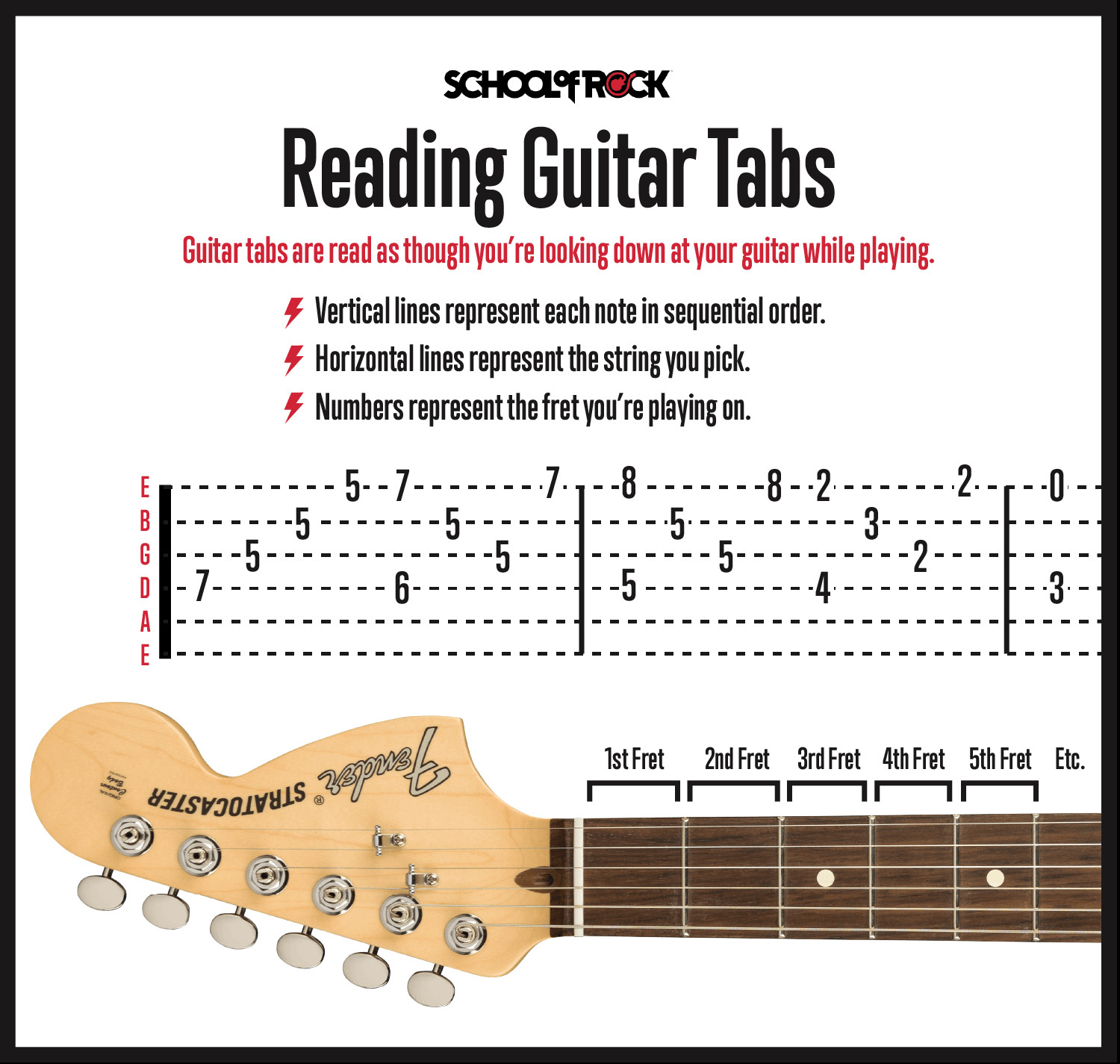 Reading guitar tabs
Reading guitar tabs
A clear representation of guitar tablature, showing the six lines representing guitar strings and numbers indicating frets to press.
Within guitar tab music sheets, you’ll also notice numbers placed on these lines. These numbers indicate the fret you need to press down on your guitar. Frets are the metal strips running across the fretboard, numbered from 0 to 24, starting at the nut (closest to the headstock) and extending along the guitar neck.
A “0” on a string means you play that string “open,” without pressing down any fret with your fretting hand. A “1” signifies playing at the first fret, “2” at the second fret, and so on. When learning how to read guitar tab music sheets, remember this simple code: each number directly corresponds to the fret number.
HOW TO READ GUITAR TABS
Guitar tab music sheets are read from left to right, just like standard text. The notes are presented in the order they are played in the song. When you see numbers stacked vertically on top of each other across multiple lines, this indicates a chord. A chord is played by strumming all the strings indicated simultaneously. For beginners, guitar tab notation is often more accessible than standard notation because it explicitly tells you which notes to play to form a chord and, crucially, where to find those notes on your guitar.
Essential Knowledge for Reading Guitar Tabs
To successfully learn how to read guitar tab music sheets, beginners should first become familiar with the names and order of the 6 guitar strings and the location of the frets along the fretboard. This foundational knowledge allows you to translate the numbers on the tab into physical positions on your guitar, enabling you to play the correct notes as guided by the tab.
UNDERSTANDING THE GUITAR TAB STAFF
The guitar tab staff may initially look similar to the staff used in traditional music notation, but there’s a key difference. In guitar tabs, the lines of the staff represent the 6 guitar strings, not musical pitch as in standard notation.
The top line is always the high E string, and the bottom line is the low E string. This direct string-to-line correspondence is what makes learning how to read guitar tab music sheets so straightforward for beginners. Typically, a guitar tab staff will also be labeled “TAB” to avoid confusion with standard music notation.
UNDERSTANDING GUITAR FRETS
Guitar frets, the thin metal strips embedded in the fretboard, are essential to understanding guitar tab music sheets.
Most guitars have between 19 and 24 frets. Each fret represents a single note or a half step (also known as a semitone) interval from the adjacent frets. Within each octave, there are 12 notes (or frets). Many guitars feature fret markers, small inlays on the side of the neck or on the fretboard itself, usually positioned at the 3rd, 5th, 7th, 9th, and 12th frets. These markers are visual aids that help you quickly locate fret positions while playing, making it easier to navigate guitar tab music sheets.
Remember, in guitar tabs, numbers represent fretted notes, while the number “0” indicates an open string. Playing an open string means you pluck or pick the string without pressing down on any fret.
UNDERSTANDING GUITAR TAB CHORDS
Guitar chords in tab music sheets are easily identifiable by their vertical arrangement. When you see multiple numbers aligned vertically across different string lines, it means these notes are played together as a chord. Even if a chord is arpeggiated – meaning the notes of the chord are played individually rather than strummed together – in guitar tabs, it will appear as a sequence of single notes even though you are technically playing the constituent notes of a chord.
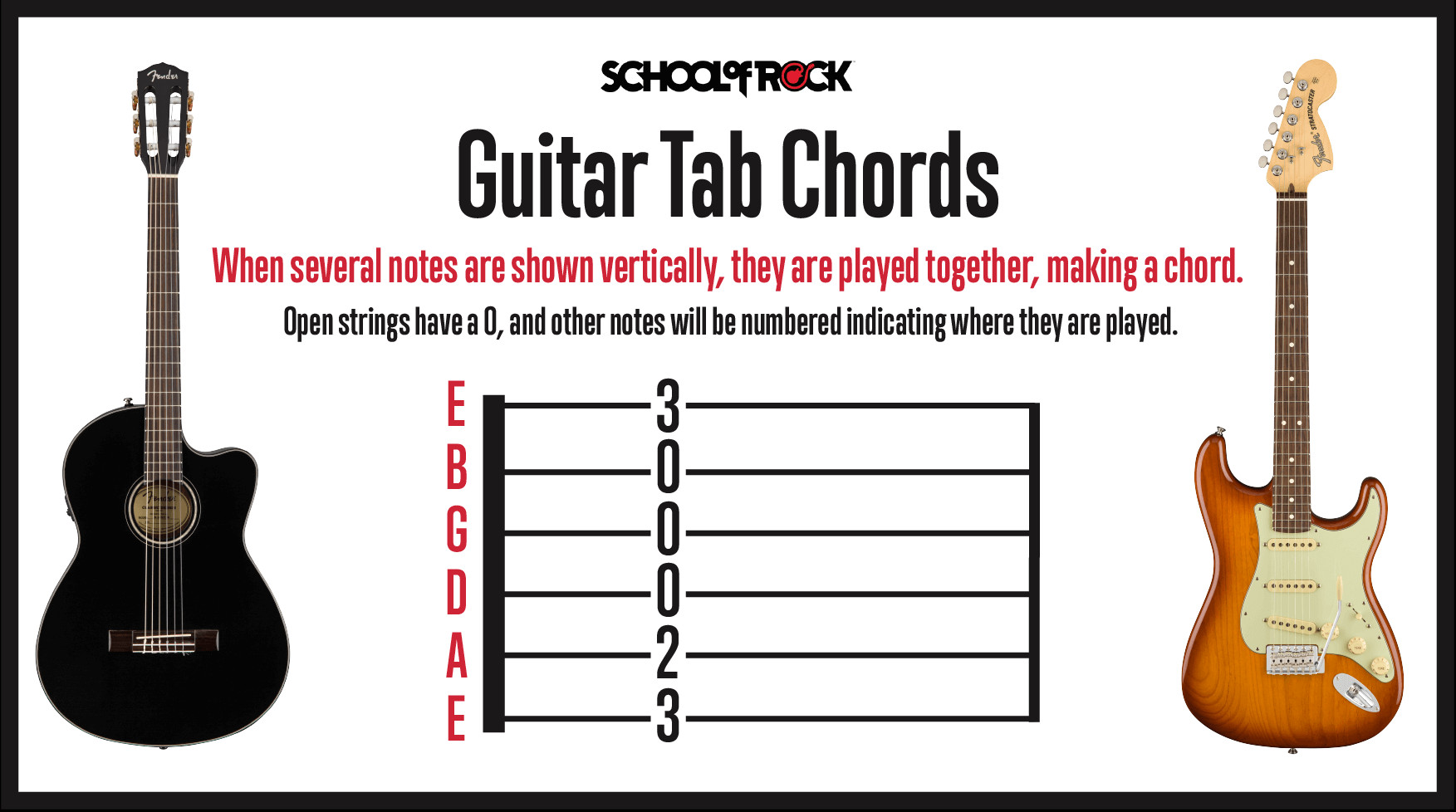 How to read guitar tab chords
How to read guitar tab chords
This image illustrates how chords are represented in guitar tabs, with vertically aligned numbers indicating notes played simultaneously to form a chord.
UNDERSTANDING GUITAR TAB RIFFS
Many popular guitar-based music genres, especially rock, heavily feature “riffs.” Riffs are short, repeated musical phrases that often form the backbone of a song. In guitar tab music sheets, riffs are typically shown as combinations of single notes and partial chords, such as power chords. The same principle applies to riffs as to chords: when two or more notes are vertically aligned, they are played at the same time. This consistency makes learning how to read guitar tablature for riffs both quick and intuitive.
UNDERSTANDING GUITAR TABS VS. CHORD CHARTS
Guitar tab music sheets and chord charts serve different but complementary purposes. A chord chart is a visual diagram depicting where to place your fingers on the fretboard to form a specific chord. Chord charts often include finger numbers to guide your fretting hand. They are frequently placed above the lyrics of songs to indicate chord changes.
However, chord charts typically only show the root chords and may not capture the nuances of a full guitar arrangement. A complete song arrangement might include single notes, notes outside the basic chord structure, or arpeggios, which are not shown on a basic chord chart. For this reason, chord charts are often used alongside guitar tab music sheets, especially for beginners. Chord charts help guitarists grasp the basic chord shapes, while tabs provide the complete musical picture, including melodies, riffs, and more complex chord voicings.
UNDERSTANDING FINGERS AND NUMBERS IN TABS
Guitar tab music sheets are linear, representing the musical timeline, whereas chord charts are like snapshots of the fretboard showing chord shapes. Chord charts use a numbering system to indicate which fingers of your fretting hand to use. The index finger is typically numbered 1, the middle finger 2, the ring finger 3, and the pinky finger 4.
In contrast, the numbers in guitar tab music sheets indicate the fret number, not which finger to use. Therefore, easy guitar tabs sometimes incorporate chord charts to guide beginners with hand positioning while playing, supplementing the fret numbers in the tab itself.
PLAY GUITAR IN REAL PERFORMANCES ONSTAGE
Our music programs are led by experienced, practicing musicians dedicated to helping you learn effectively. Gain performance experience and hone your skills in a supportive environment tailored for all levels.
HOW TO READ GUITAR TAB SYMBOLS
Beyond lines and numbers, guitar tab music sheets often use a variety of symbols to indicate specific guitar techniques. Learning to recognize and apply these symbols is crucial for achieving an authentic sound and making reading guitar tabs even easier.
Before you start playing any guitar tab, always ensure your guitar is properly tuned. Playing with correct tuning is fundamental to making your guitar sound right.
MUTING GUITAR NOTES
Muting is a foundational technique, especially in genres like Rock, Metal, Punk, and Alternative. Different muting techniques are used to create specific rhythmic feels and sonic textures.
HOW TO MUTE GUITAR NOTES
Muting can be achieved using either your picking hand, your fretting hand, or a combination of both. Muting adds dynamic variation to your playing and is essential for achieving a polished sound. Many songs use muting in verses and then remove it for choruses or hooks to create contrast.
Experienced guitarists often incorporate muting instinctively. Especially when playing at louder volumes, muting is crucial for preventing unwanted noise and feedback.
GUITAR TECHNIQUE: PALM MUTING
Palm muting is one of the most frequently used techniques in rock guitar. It involves resting the palm of your picking hand lightly on the strings near the bridge while picking. Heavy palm muting produces a tight, percussive, rhythmic sound, while lighter palm muting allows notes to ring out with some sustain. In guitar tab music sheets, palm muting is usually indicated by “P.M.” written above the section that should be palm-muted.
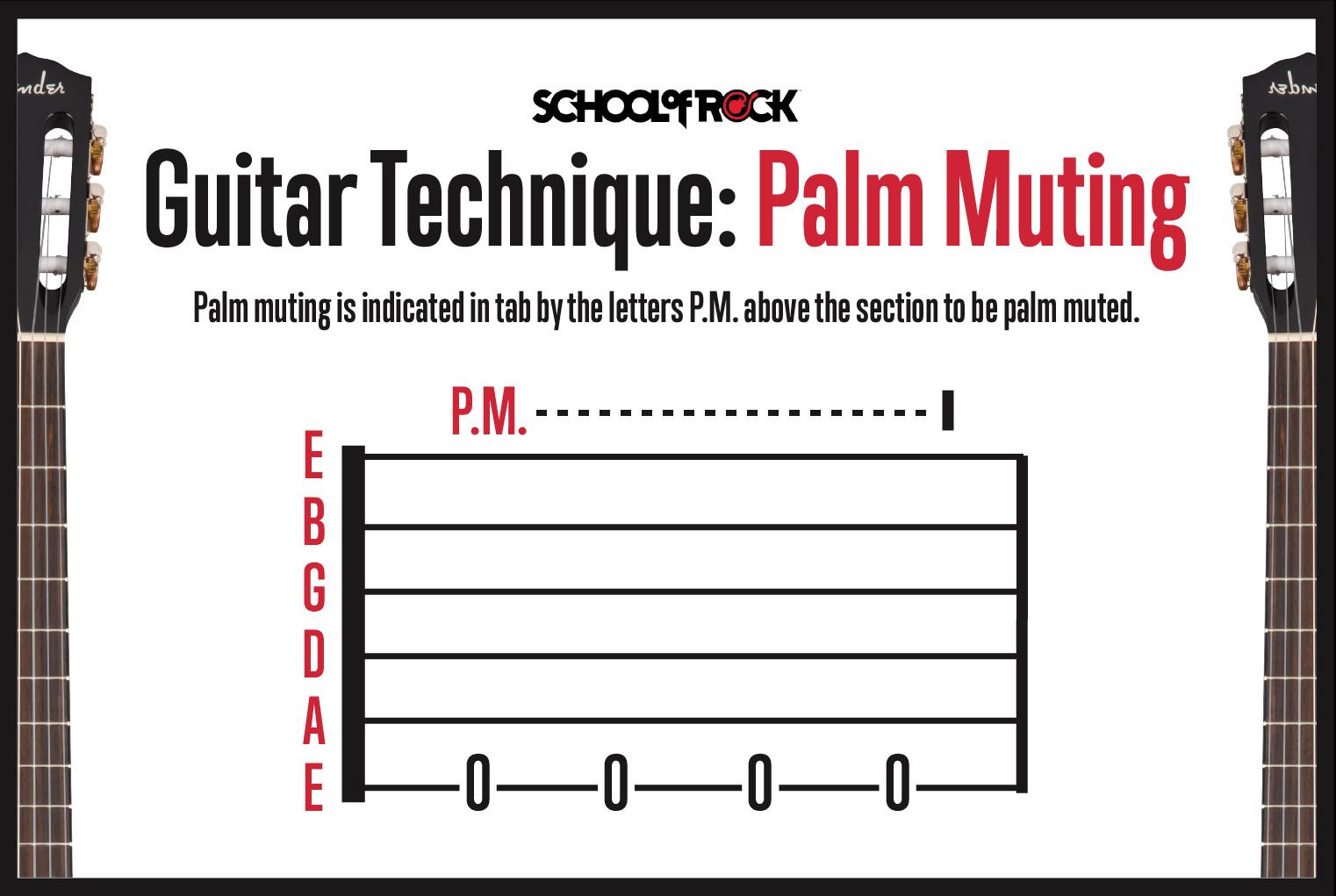 Guitar technique palm muting
Guitar technique palm muting
An illustration of palm muting technique, showing the picking hand’s palm lightly resting on the strings near the bridge to dampen the sound.
GUITAR TECHNIQUE: MUTED NOTES
Muted notes, sometimes referred to as “dead notes,” are a different technique from palm muting. They are created using the fretting hand. In guitar tab music sheets, muted notes are notated with an “X” where a fret number would typically appear. You still pick the string, but the fretting hand lightly touches the strings without pressing them down fully to the fretboard. This produces a percussive, muted sound rather than a clear pitch.
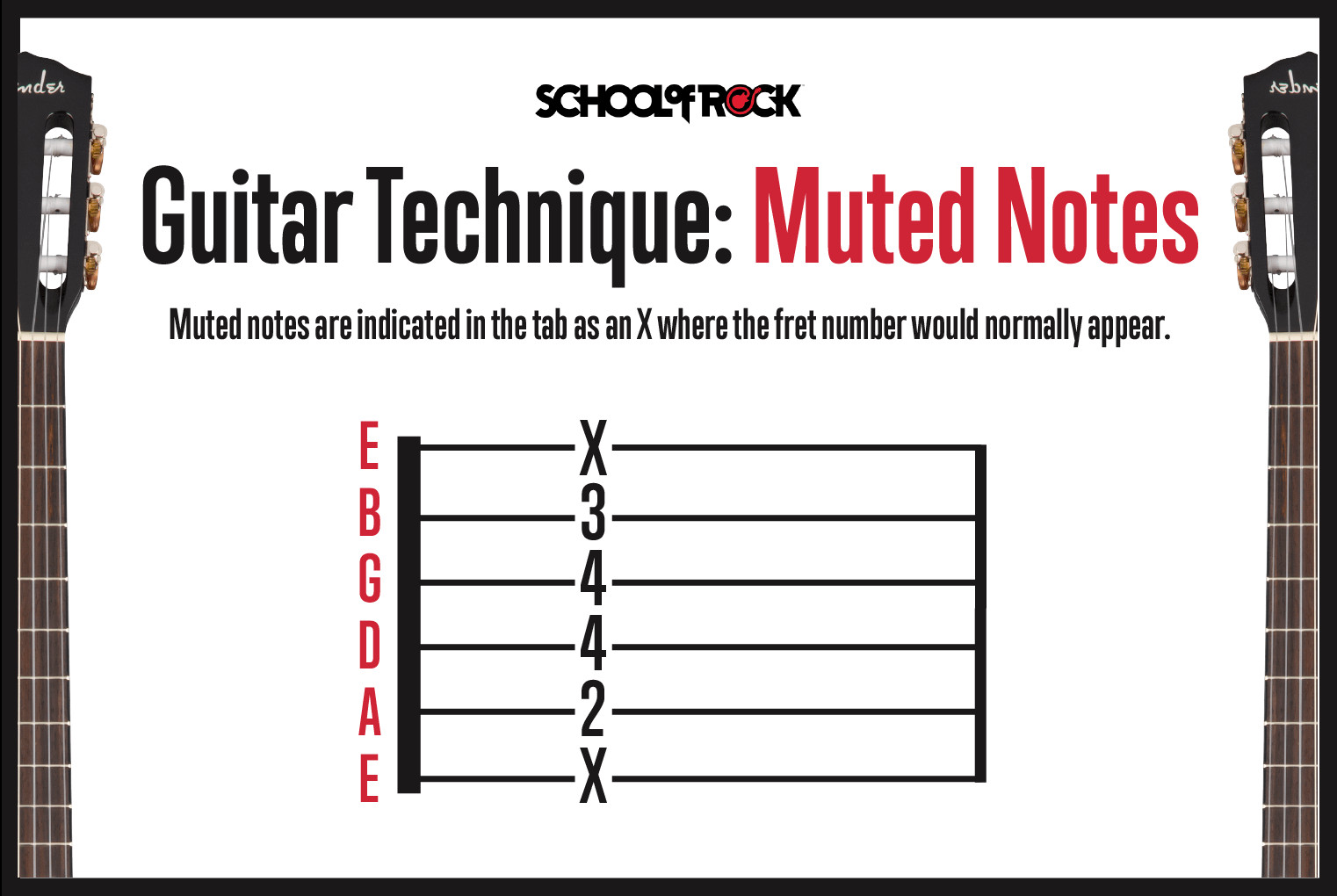 Guitar technique muted notes
Guitar technique muted notes
This image demonstrates the muted notes technique, where the fretting hand lightly touches the strings to create a percussive, dampened sound.
BENDING GUITAR STRINGS
String bending is a technique that adds expressive, vocal-like qualities to guitar playing. In guitar tab music sheets, bends are indicated by a curved arrow above the note to be bent. The arrow will often specify the extent of the bend, such as “½” for a half step bend (one fret higher) or “full” for a full step bend (two frets higher). These target pitches are often referred to as “target notes.”
HOW TO BEND GUITAR STRINGS
Bending is achieved by pushing or pulling the string sideways along the fretboard, rather than pressing straight down. For most strings (except the low E), you typically push the string upwards towards the ceiling. The low E string is usually bent downwards towards the floor. The key to a good bend is applying smooth, consistent pressure throughout the bend.
GUITAR TECHNIQUE: BENDING GUITAR STRINGS
Most string bends are performed using a combination of fingers for strength and control. Typically, the ring finger is the primary fretting finger, with the middle and index fingers providing support and reinforcement. This multi-finger approach makes bending smoother, easier to control, and helps in accurately reaching the desired pitch.
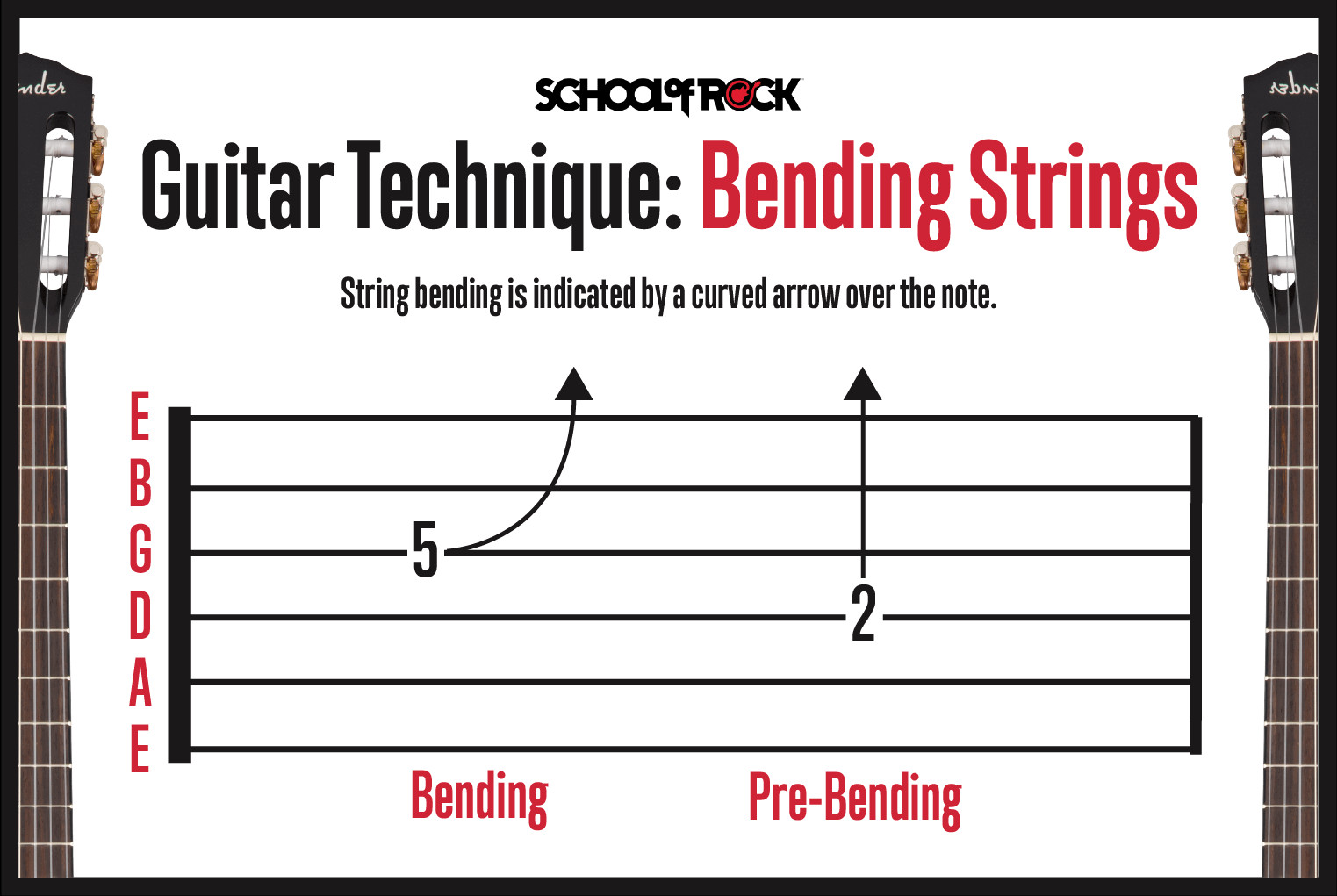 Guitar technique bending strings
Guitar technique bending strings
An illustration of the string bending technique, highlighting the motion of pushing the string across the fretboard to raise the pitch.
GUITAR TECHNIQUE: PRE-BENDING GUITAR STRINGS
When learning how to read guitar tab music sheets, you might also encounter “pre-bends.” A pre-bend involves bending the string to the target pitch before picking the note. The tab notation shows this with an upward arrow indicating the bend amount (full, ½, etc.), followed by a downward curved arrow indicating the release of the bend back to the original pitch after picking. Pre-bends can either be released back to the original fretted note or bent further upwards to a different target note.
SLIDING GUITAR NOTES
Sliding is another essential guitar technique that creates a smooth transition between notes. You can slide up to a higher note or down to a lower note. Sliding differs from bending because you move your fretting finger along the fretboard to the next fret, maintaining contact with the string throughout the slide.
GUITAR TECHNIQUE: SLIDE UP
In guitar tab music sheets, a slide up is represented by a diagonal line slanting upwards between the starting note and the ending note of the slide.
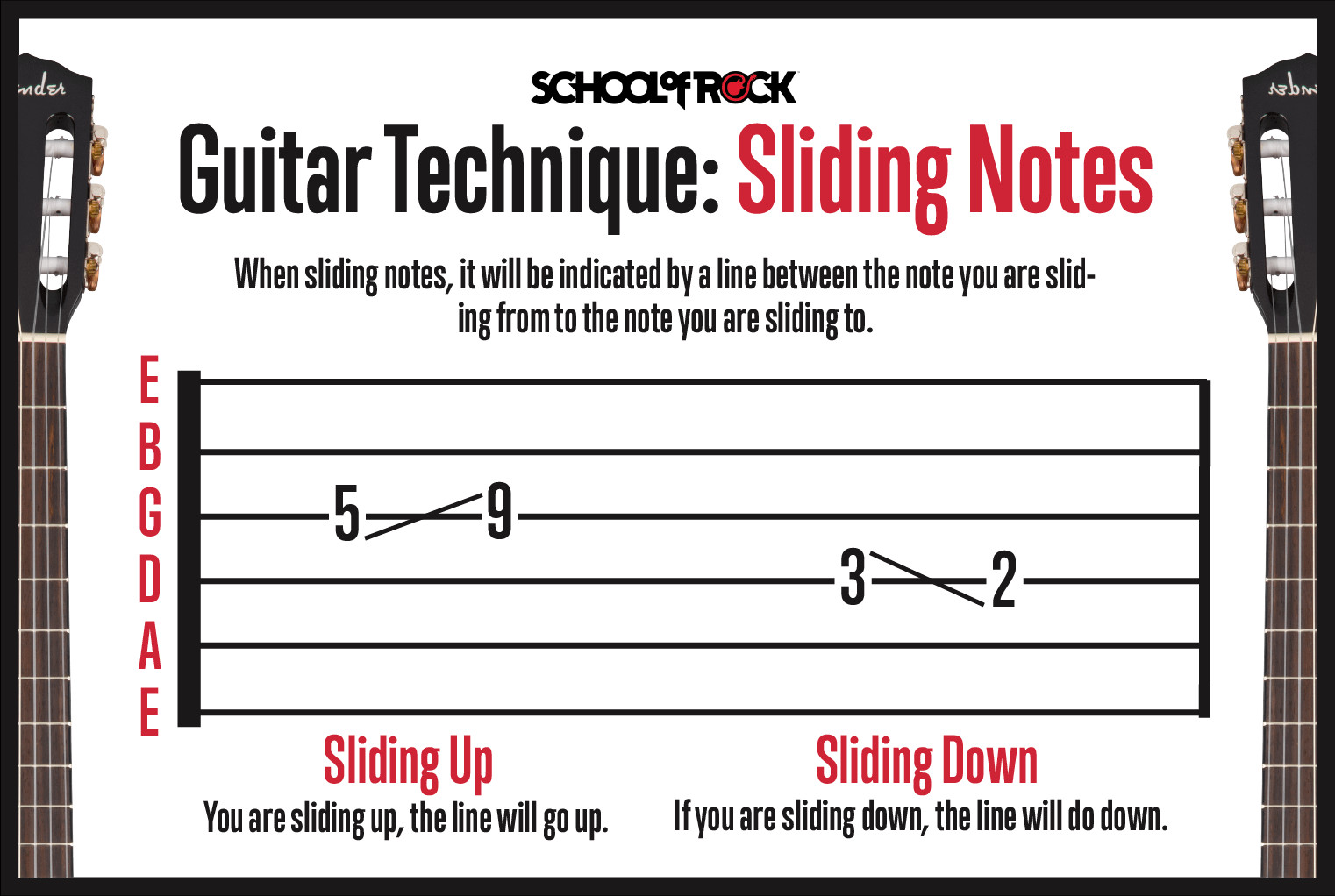 Guitar technique sliding notes
Guitar technique sliding notes
This image shows the sliding technique in guitar tabs, with a line connecting two fret numbers to indicate a slide between notes.
GUITAR TECHNIQUE: SLIDE DOWN
Conversely, a slide down in guitar tab music sheets is indicated by a diagonal line slanting downwards between the starting and ending notes of the slide.
PLAYING HAMMER-ONS ON THE GUITAR
A hammer-on is a guitar technique where you create a note by “hammering” your fretting finger onto the string, rather than picking the string again. You can hammer-on from an open string or from a previously fretted note, and the resulting note will be higher in pitch. In guitar tab music sheets, hammer-ons are shown with the letter “H” and a curved arc connecting either an open string “0” to the hammered-on note or connecting a fretted note to a higher hammered-on note.
HOW TO PLAY HAMMER-ONS ON THE GUITAR
To execute a hammer-on, strike the guitar string with your fretting finger with enough force to make the note sound clearly without picking it. This takes practice to achieve a strong, clear tone. Hammer-ons are generally easier to perform on electric guitars, especially at higher volumes. Start practicing hammer-ons by playing an open low E string and then hammering-on to the third fret with another finger, holding the note to let it ring. Repeat this exercise on different strings and frets.
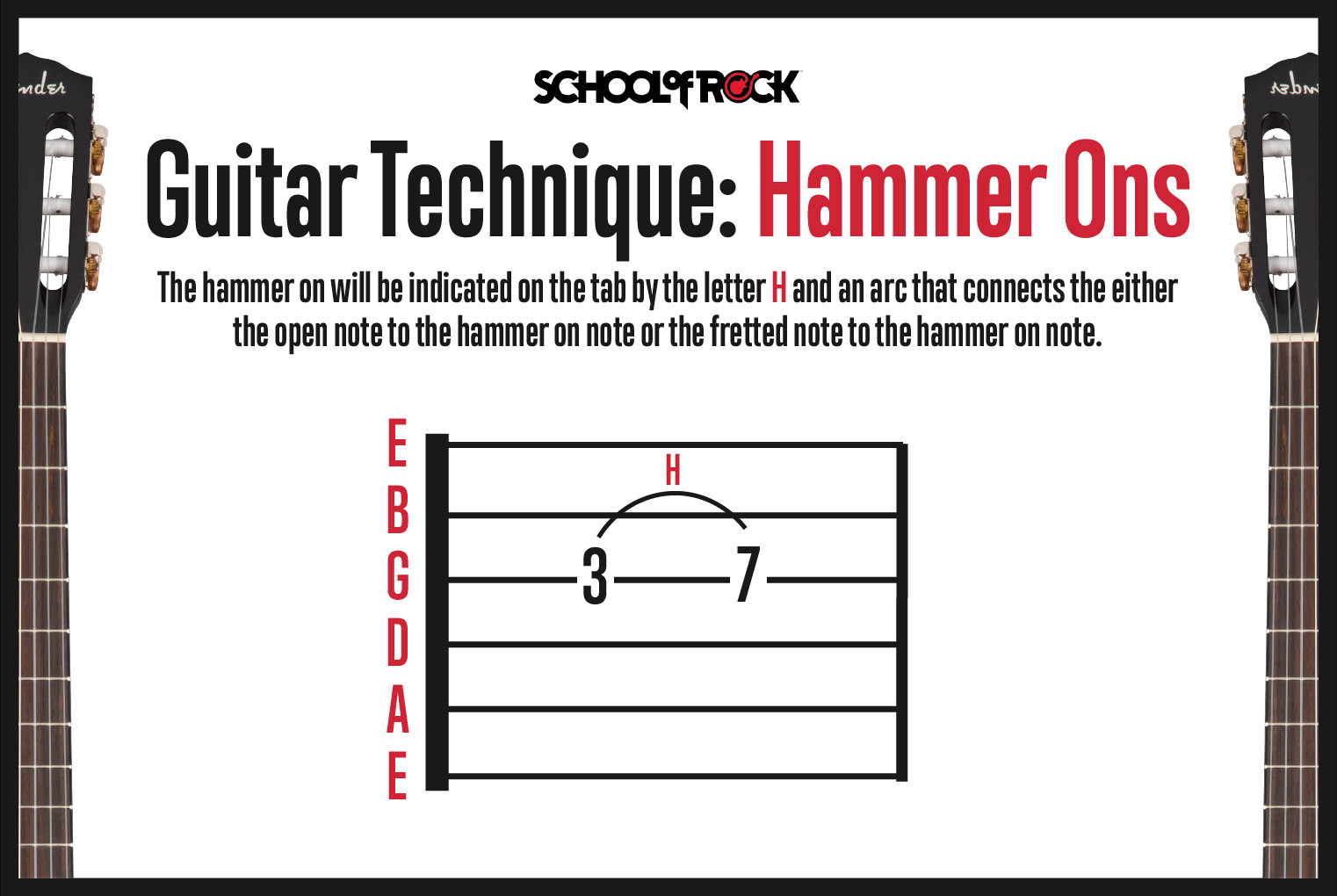 Guitar technique hammer ons
Guitar technique hammer ons
An illustration of the hammer-on technique in guitar tabs, showing an arc and “H” connecting two notes, indicating a hammer-on.
PLAYING PULL-OFFS ON THE GUITAR
Pull-offs are the opposite of hammer-ons. Instead of hammering onto a string, you “pull-off” a fretted finger to sound a lower note, which could be an open string or another fretted note. In guitar tab music sheets, pull-offs are indicated by the letter “P” and a curved arc connecting the pulled-off note to the resulting lower note.
HOW TO PLAY PULL-OFFS ON THE GUITAR
To perform a pull-off, fret a note and then pull your finger off the string in a downward or sideways motion, plucking the string enough to sound either an open string or a lower fretted note. When playing pull-offs, ensure you “grab” enough of the string with your fingertip to create a clear sound as you pull away.
Hammer-ons and pull-offs can be combined in alternating sequences, often referred to as “trills,” creating rapid, fluid musical passages.
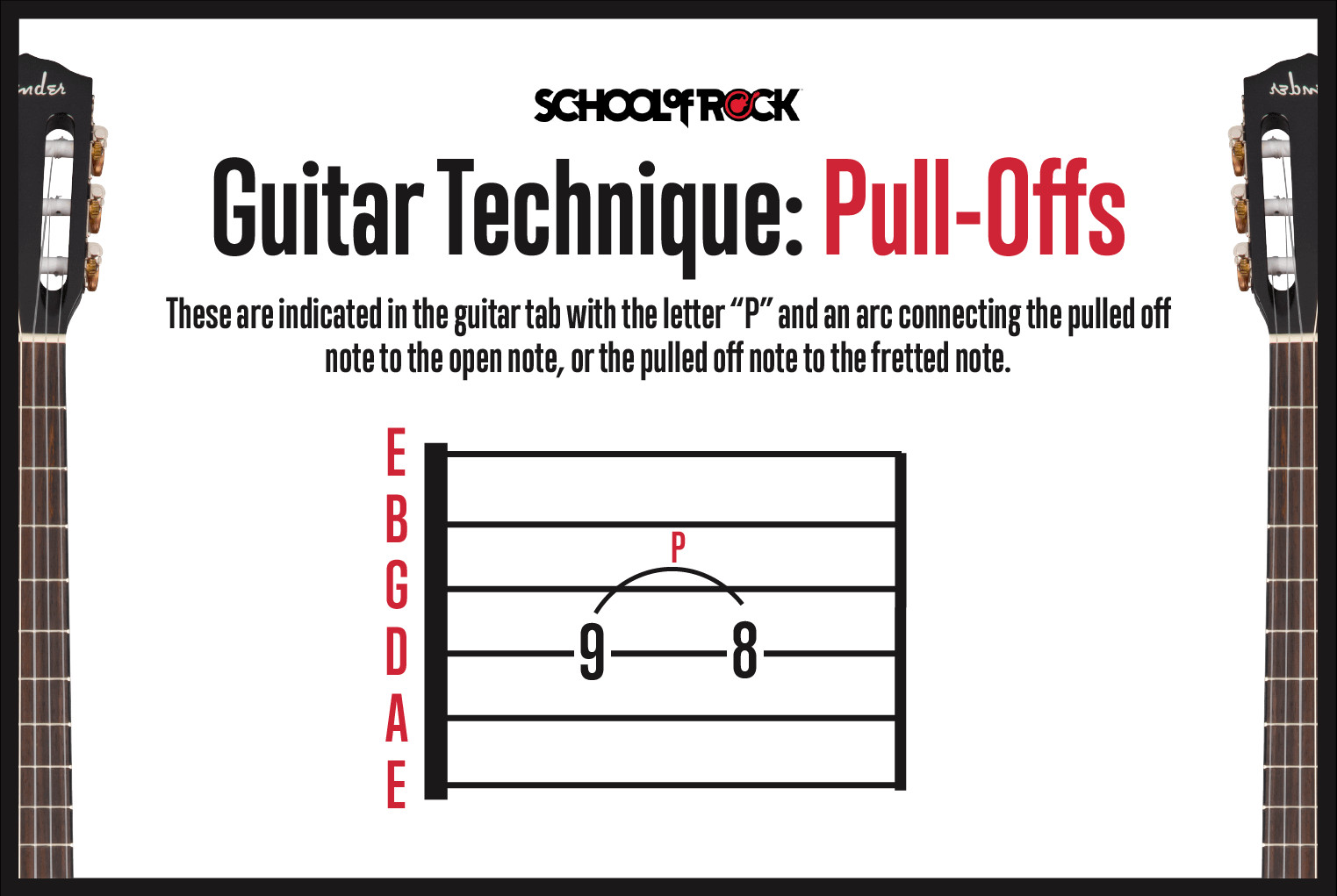 Guitar technique pull offs
Guitar technique pull offs
This image depicts the pull-off technique in guitar tabs, with an arc and “P” connecting two notes, representing a pull-off.
PLAYING VIBRATO ON THE GUITAR
Vibrato is a technique used to add expression and warmth to notes by creating a slight, rapid fluctuation in pitch. It involves repeatedly bending a note slightly up and down from its original pitch without releasing the fretting pressure. In guitar tab music sheets, vibrato is typically represented by a zig-zag line above the staff. The length of the zig-zag line can indicate the duration of the vibrato. Generally, a longer line suggests a longer vibrato.
HOW TO PLAY VIBRATO ON THE GUITAR
Vibrato is similar to bending but involves much smaller pitch variations. You can apply vibrato using a single finger or by using your main fretting finger supported by others for added control. Begin practicing with a slow, smooth vibrato and then experiment with varying speeds to achieve different expressive effects. Like bending, vibrato is a very personal technique; every guitarist’s vibrato is unique, contributing to their individual playing style.
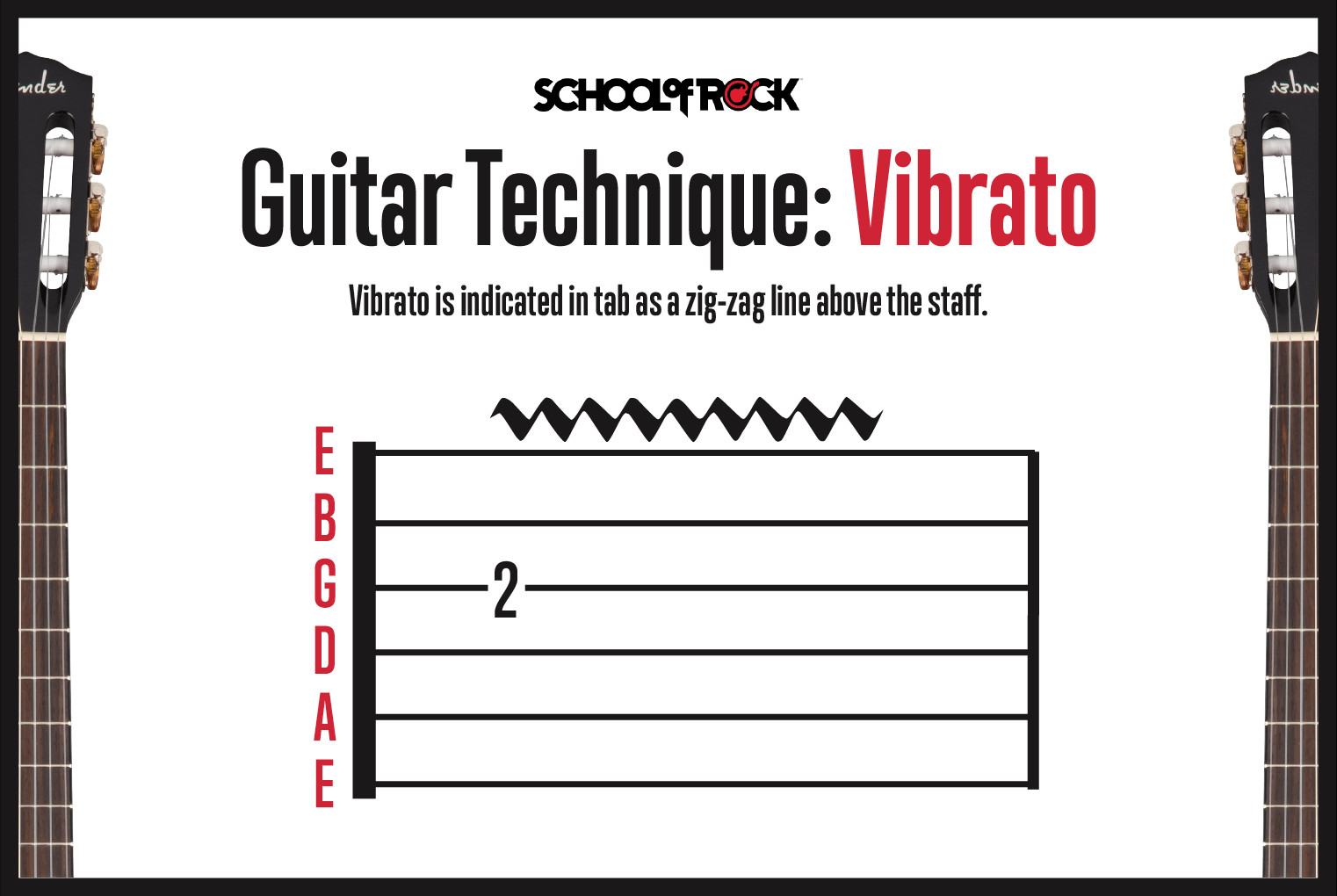 Guitar technique vibrato
Guitar technique vibrato
An example of vibrato notation in guitar tabs, shown as a zig-zag line above the note, indicating the use of vibrato.
TAPPING GUITAR
Tapping is an advanced guitar technique where you fret notes with your regular fretting hand and also “tap” or fret notes on the fretboard using a finger from your picking hand. The picking-hand tap is essentially a variation of a hammer-on. Tapping is notated in guitar tab music sheets with the letter “T” placed above the tapped note.
HOW TO FINGER TAP GUITAR
Tapping was popularized by Eddie Van Halen but has roots in classical guitar. To finger tap, fret a note with your regular fretting hand and then “tap” a higher note on the same string using your picking hand’s index finger.
Finger tapping extends the range and speed at which you can play notes, allowing for wide intervals that are impossible to reach using only your fretting hand. Playing with overdrive or distortion and at a decent volume often enhances the sound and ease of tapping. Because you are effectively using both hands to fret notes, tapping enables very rapid playing.
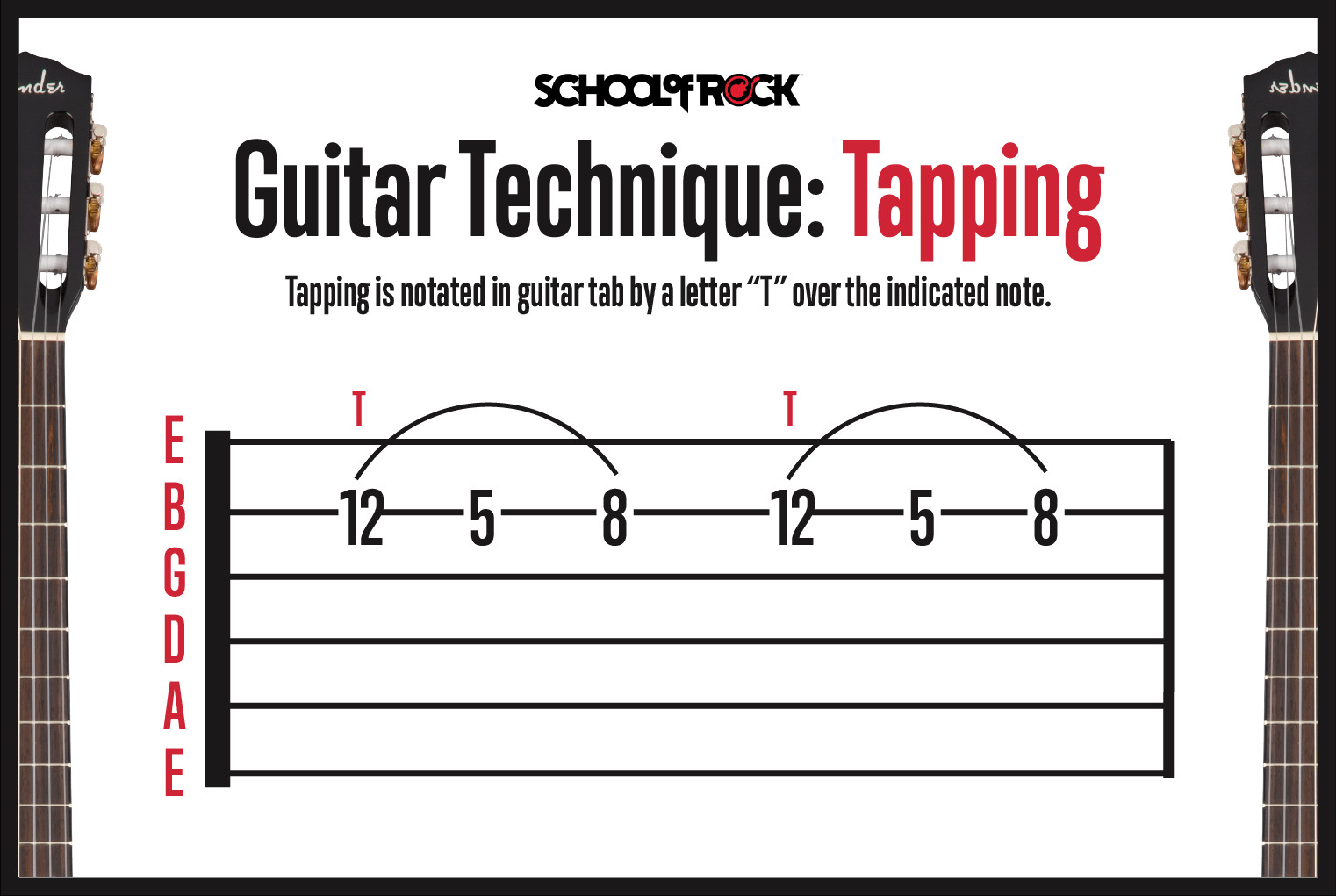 Guitar technique tapping notes
Guitar technique tapping notes
This image demonstrates the tapping technique in guitar tabs, with a “T” above a note indicating a tapping action.
GUITAR TECHNIQUE: TWO-HANDED TAPPING
Two-handed tapping takes the tapping technique further. It involves both the fretting and picking hands independently tapping notes, without traditional picking. This technique can be used to play bass lines with the fretting hand while simultaneously tapping melody or solo lines with the picking hand, creating complex and layered textures.
STRUMMING GUITAR NOTES
When strumming chords on a guitar, there are two primary strumming directions: downstrokes and upstrokes.
Downstrokes are played from the lower strings towards the higher strings using a downward motion of the pick or strumming hand. In guitar tab music sheets, downstrokes are symbolized by a thick horizontal line with two short vertical “legs” pointing downwards on either side.
Upstrokes are the opposite, played from the higher strings towards the lower strings with an upward motion. In guitar tab music sheets, upstrokes are notated by a “V” shaped symbol placed above the strummed chord.
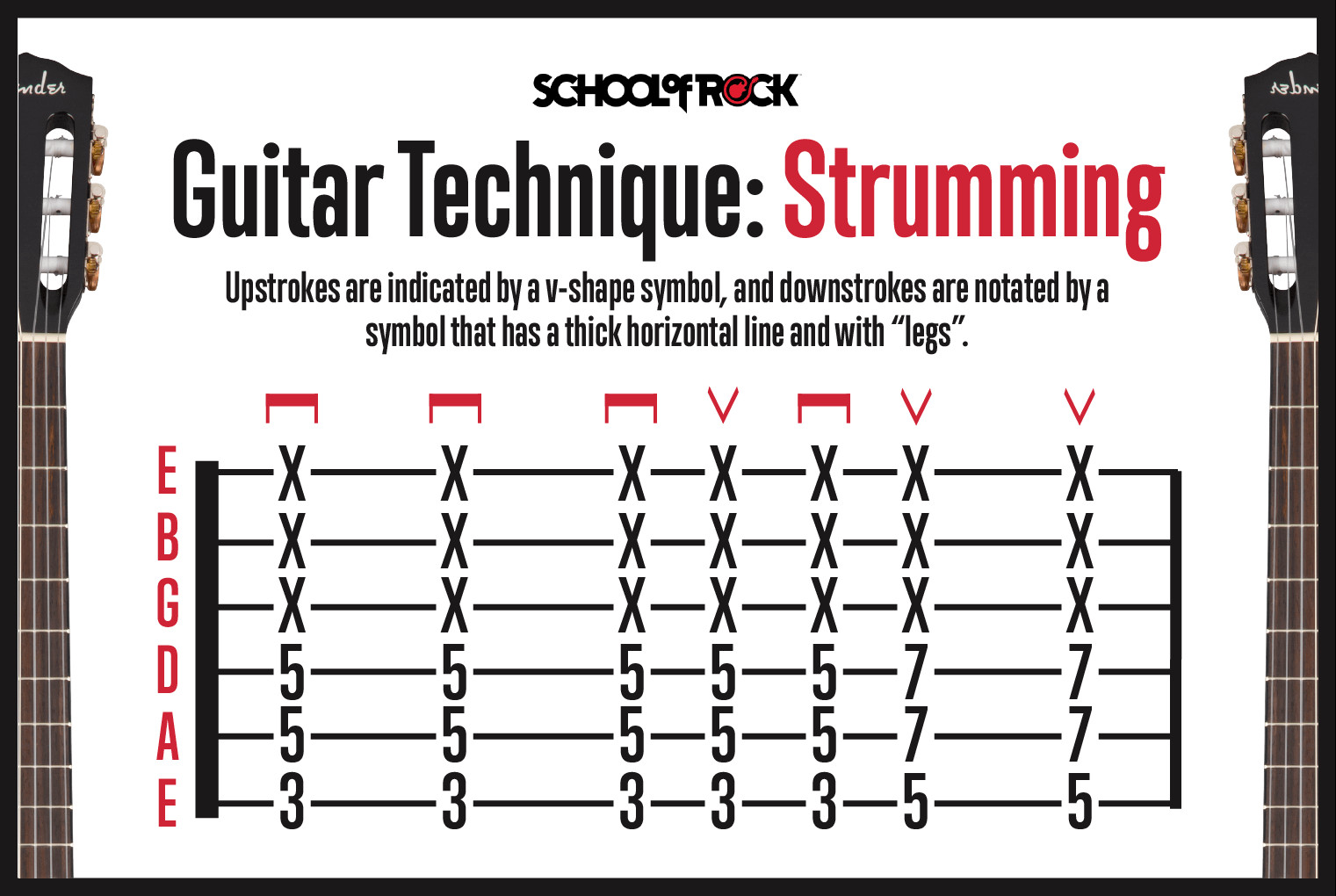 Guitar technique strumming
Guitar technique strumming
An illustration showing strumming notation in guitar tabs, with symbols for both downstrokes and upstrokes.
HOW TO STRUM GUITAR NOTES
Various strumming patterns are used when playing chords, depending on the song’s rhythm and style. You can strum using a consistent downstroke or upstroke pattern, or combine them in countless variations. Songs with an eighth-note rhythm are often counted as “1 and 2 and 3 and 4 and…” Many songs use alternating downstrokes and upstrokes in an eighth-note rhythm, with downstrokes on the numbered beats (1, 2, 3, 4) and upstrokes on the “ands.”
GUITAR TECHNIQUE: PLAYING DOWNSTROKES AND UPSTROKES FOR SINGLE NOTES
The same downstroke and upstroke notation applies even when playing single notes in guitar tab music sheets, not just chords. A downstroke, indicated by the horizontal bar with “legs,” means your pick moves downwards as you play the note. Conversely, an upstroke, marked with a “V,” means your pick moves upwards.
READY TO LEARN OTHER GUITAR TECHNIQUES?
Now that you understand how to read guitar tab music sheets and are familiar with many common guitar techniques, you’re well-equipped to start playing! From beginners to advanced players, guitarplayers.net is dedicated to helping students learn guitar and reach their musical goals. From basic strumming to advanced tapping, our resources and instructors offer the knowledge and experience to help you quickly learn to play your favorite songs.
Eager to find guitar tab music sheets to play? Whether you’re looking for easy songs for beginners or challenging pieces for experienced musicians, guitarplayers.net has resources for you. Explore a wide range of high-quality sheet music at Sheet Music Direct.
Thinking about getting a new guitar? Check out our Guitar Buying Guide!
